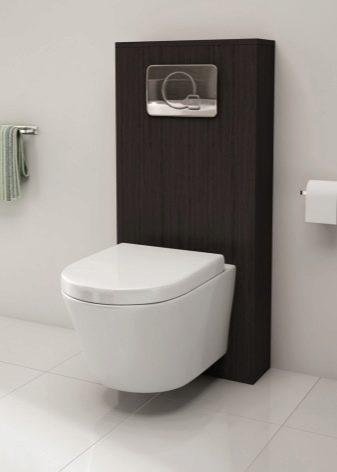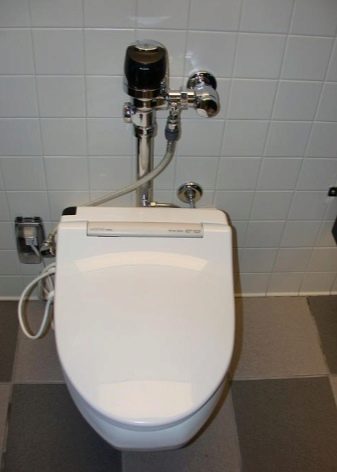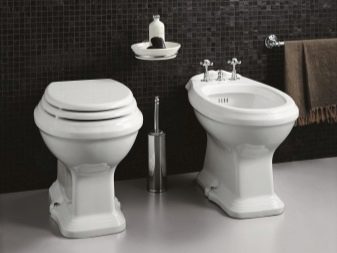Toilet bowls without a cistern: pros and cons, varieties, choice

Recently, the so-called toilets without a cistern are becoming more and more popular and in demand. From the name of this plumbing device, we can conclude that the last detail is really not in it, although in fact it is present, but "hidden" in the wall. Today we will take a closer look at similar products and find out what their advantages and disadvantages are.
Features and device
Modern models of toilet bowls are presented in a wide range. Popularity began to be enjoyed not only by the classic, but also by versions of the suspended, attached type, which have a so-called hidden tank. Such plumbing looks unusual, but aesthetically pleasing and neat.
The range of toilets with a hidden cistern today pleases with its diversity. You can choose the right option for every taste, color and budget. Plumbing is made from different materials and may differ in its structure and direct work.


The operation of devices without a tank can be easily carried out thanks to such details as drukspühler... It can be installed in different ways: outdoor or remote. Both options will not take up a lot of free space in the bathroom, but they will affect the interior design in different ways. Such systems are widespread today and are in enviable demand.
You should also know what a drukspühler is. This is a German term for draining water by pressing on the mechanism.

Modern plumbing equipment makes it possible to competently and efficiently equip even very small premises, and in fact in most dwellings the toilet has a modest square. Cistern-less toilets are a win-win solution in these conditions.
It does not matter at all what the structure of the toilet is - suspended or attached, floor-standing. If a flush tank is not provided, then Drukspühler can be safely installed.


If the toilet is suspended, then the drain system in it can be exclusively built-in. On the surface of the wall in the bathroom or a structure sheathed with a special frame, the previously mentioned button is installed, which is responsible for the drain.
Such systems are very similar to the console versions of toilets with installation or a built-in cistern.


If we are talking about a cisternless toilet, a floor-standing type, then it can be supplemented with both a built-in flush system and an external one. So, in terms of its external characteristics, the external Drukspühler is very similar to the system intended for a classic urinal: a chrome-plated or painted pipe comes out of the wall with a button or drain lever.


The tank is a storage tank. The required water pressure is provided by the natural pressure of the "water column". The flush operation of the Drukspühler is dependent on the pressure that takes place in the water supply and the design of the toilet bowl. This is where the main difference between the Drukspühler and the standard tank lies. It is a kind of membrane-type faucet that serves as a connection between a tankless toilet and a water pipe.
The principle of operation for the part in question is similar to the straight-through diaphragm of the valve.
If you compare the internal structure of a Drukspühler, you will notice that it is more complex than that of simple cranes. It also has 2 chambers that are connected to each other by a through hole with a check valve. The main feature of the Drukspühler design is that it must be opened manually, and the closing is automatic.


Advantages and disadvantages
Modern toilets without a cistern of the standard type have their positive and negative sides. It is recommended to purchase such a plumbing item only after a detailed acquaintance with those and other parameters.

Let's figure out the advantages of such systems.
- The main advantage of cisternless toilets is their attractive appearance. Such an item of plumbing is not striking, does not burden the situation, it looks modern and unusual. This model will especially appeal to people who prefer modern interior styles.
- This type of design is shorter than the traditional toilet bowls that everyone is used to. Thanks to this difference, devices without a cistern turn out to be miniature and take up a minimum of free space in the bathroom. When it comes to organizing a very small space, such a model will be the best solution.
- Tankless toilets are distinguished by increased hygiene, because cleaning such devices is much easier than traditional devices.
- Since the cistern of such a toilet is hidden, and without unnecessary manipulations it will not be possible to see it, visually the bathroom may seem much more spacious and lighter.
- If a toilet bowl without a cistern has a suspended structure, then under it you can easily and simply wash the floors, keeping the room perfectly clean without unnecessary hassle.


But these products also have their weaknesses.
- The main disadvantage of toilets without a cistern is the high complexity of their installation in the bathroom. This is especially true for ultra-fashionable wall-mounted models, since they will need to install a powerful installation.
- Such devices are much more expensive than their classic "counterparts". This is one of the main reasons why consumers prefer to refer to the "classics".
- Maintenance and repair of such devices are highly complex. If the toilet needs to be repaired, you will have to resort to serious damage to the finish in the bathroom. If this is a tile, then such procedures can cost a tidy sum.
- If the toilet is powered by the Drukspühler system, then it will work normally only if there is a good water pressure. In the water pipes of city apartments, the pressure may not be enough, especially when it comes to the summer months.


Varieties
Modern toilet bowls without a cistern, working due to the German Drukspühler system, are divided into 2 main types:
- hinged;
- floor (attached).


Hinged
Console toilets (hinged) are attached to the wall in the bathroom. Of course, the base must be solid and strong. It makes no sense to attach such a plumbing device to a drywall sheet. The installation of such a tankless device is difficult and time-consuming. Here you will have to make a metal structure, which will play a load-bearing role. Usually the installation is made of square pipes, but there may be other options.

The reliability of such designs confuses many users. In fact, modern wall-mounted toilets with a hidden cistern can easily withstand a weight of more than 400 kg, therefore the weight of a person is not dangerous for them.
The tank for such products may differ from the classic models. Outwardly, it looks more like a simple plastic canister, but its principle of operation is similar to the traditional technique.
The only peculiarity is that the drain drive is represented here by levers.


Attached
Floor mounted models of toilet bowls attract consumers by the fact that you don't need to mount a powerful installation for them. The entire load from the weight will fall only on the floor in the bathroom. In order to hide the tank of such a product, you will have to build a false wall from drywall sheets. Instead, you can use a special pipe. In certain situations, the tank is walled up in the wall.

The installation process of such a toilet bowl may not be the most difficult. Everything here will depend on the placement of sewer pipes in the dwelling. Attachments can be considered optimal between console and classic products.


Types of systems
The Drukspühler system, which is popular today, is realized thanks to the cartridge, which is divided into the 2 cameras mentioned earlier. These elements are required to create a pressure difference, due to which the drain is provided.

The Drukspühler system can have only 2 connection points:
- directly to the water supply;
- to the branch pipe through which the liquid is sent down.
It is worth noting that Drukspühler takes up much less free space than in the case of a cistern and classic systems. The choice of a specific design for this device depends only on the preferences of the homeowners.


Flush systems for cisternless toilets can be external or internal. Both the first and the second are perfectly perceived visually. The variant of the hidden Drukspühler looks like a simple wall-hung toilet bowl with the provided installation. If we are talking about installing the system externally, then here the gaze appears to be a small chrome-plated tube, into which a liquid supply button is built.


How to choose?
If you decide to abandon traditional plumbing and want to purchase a modern tankless device, then you should consider a number of basic criteria that allow you to choose a really high-quality and durable product that will not bring hassle and problems.
- Material. As with classic toilets, it is important to pay attention to the material from which the model without a cistern is made. Available, widespread, reliable and strong are earthenware specimens.If you want to buy a more chic option, then you can choose a porcelain toilet, but this material is susceptible to mechanical damage, and outwardly it is very difficult to distinguish it from the more affordable faience.
- System. Initially, decide on what kind of flush system you want to see in your bathroom. Here, each owner decides for himself what will be most convenient and optimal for him.
- Dimensions. As a rule, toilets without a cistern are compact and fit easily even into very small rooms, but before visiting the store, it is still better to measure the bathroom and choose the appropriate model based on the parameters identified.
- Design... Consider the design of the product you choose. The toilet should harmoniously fit into the bathroom environment.
- Brand name... It is recommended to buy products from well-known manufacturers. Branded products are often expensive (especially tankless), but they serve for a long time, are produced according to all standards, and strict quality control is carried out at all stages of their production. Usually, plumbing from well-known companies does not cause unnecessary problems for consumers, so you should not buy products from incomprehensible, dubious manufacturers.





For information on how to independently install a cistern-free toilet, see the video below.








